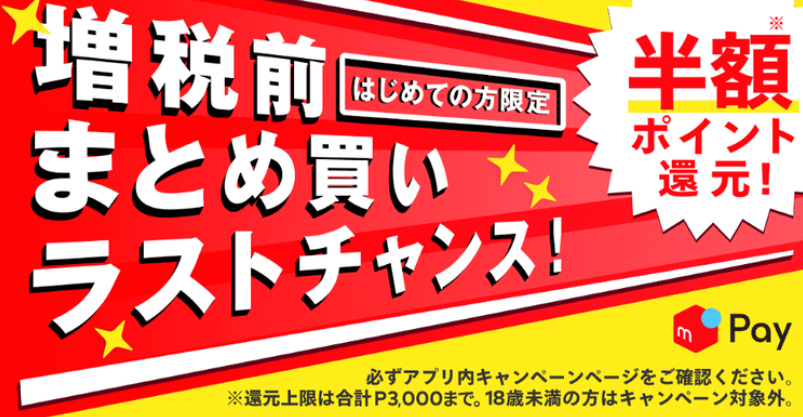 Marketing
Marketing
Consumer tax hike in Japan: how has it impacted…
By Ryoko Ward
From 1st October, the VAT rate in Japan was increased from 8% up to 10%, marking the first change since April 2014, when it was raised from 5% to 8%. There was significant interest among Japanese consumers in stocking up on items right before the higher tax rate officially came into effect.

What does the tax hike in Japan mean for consumers?
The tax hike in Japan is applicable to the vast majority of goods and services obtained within the country, but there are some exceptions, such as food items in order to ease the burden for low-income households. The tax rate for take-out food, for instance, remains at 8%, whilst food consumed at a restaurant or cafe is taxed at the higher 10% rate.
Here are some examples of major campaigns that have been put out by local brands that are designed to encourage consumers to take advantage of existing cheaper rates, or claim money back.
Mercari — MerPay

Mercari, one of the largest and fastest-growing e-commerce companies in Japan, launched a campaign entitled ‘Pre-VAT-Increase Bulk Buying! Reward Points for Half Price!’. This was limited to those who registered online with Mercari for the first time and for those earning up to 3,000 points, Mercari offered reward points equivalent to 50% of the price customers paid to buy products using ‘MerPay’ during the campaign period. It was initially planned to run between 18th and 30th September, but it was so popular that they decided to extend the campaign to 4th October.
Rakuten

Rakuten, the most prominent e-commerce platform in Japan, launched a campaign that rewards Rakuten Pay (affiliated with Rakuten credit cards) users with 5% points up to the value of 5,000 points. They have a longer campaign period which lasts till 31st December this year. Rakuten also offered a campaign to benefit first time users, through which customers could get 400 Rakuten points if they purchase more than 700 JPY worth of goods at selected convenience stores or drug stores.
Rakuten also set up a dedicated website explaining the new VAT system to customers. They published results from a survey they had conducted with Japanese consumers, detailing what they intended to buy before the increase, followed by links to the top products on Rakuten. Popular items included; medicine, contact lenses, alcohol, pet food, PC-related gadgets, home electronics, and fashion items such as clothes, bags and shoes. According to Rakuten’s survey, daily necessities such as toilet rolls and tissue paper were most popular when it came to bulk buying.
PayPay
PayPay is one of Japan’s most popular online payment platforms, launched by Yahoo! Japan and SoftBank Mobile in 2018. Up until 30th September, users who paid via PayPay between the hours of 10am — 2pm were rewarded with up to 10% back in points (if they are existing SoftBank and Y! Mobile users; if not, they would receive 5%). However, unlike other brand campaigns that focus on pre-tax-increase, PayPay’s strategy was to give consumers a deal after the VAT hike had already taken effect.

In order to maintain consumer demand after the tax increase as well as to encourage more cashless payments, the government is subsidising some small-to-medium size businesses so they can give out extra reward points when making cashless payments. PayPay is part of this programme, and if you pay via PayPay at certain shops and stores, consumers can get up to 5% reward points. This PayPay campaign was launched on 1st October, the day of the tax increase, and will last for a month.
Don Quijote (DONKI)

It’s not just cashless payment or e-commerce platforms that launched pre-tax-increase campaigns. Don Quijote, often referred to by its shortened form ‘DONKI’, is a large Japanese discount chain. The brand announced that it would offer customers an 8% discount on particular products including daily goods and stationery items between 14th–30th September. Unlike other retailers that provide discounts only when making cashless payments, Don Quijote’s campaign was unique in that it offered a discount regardless of payment method, including cash. They did, however, offer preferential treatment to those paying via Majica (their proprietary cashless payment platform) by rewarding users with 13% of the total cost back in reward points.
Cocokarafine

Cocokarafine is one of the leading drug store chains in Japan. Their pre-tax hike campaign gave consumers the chance to apply for vouchers when they spent more than a certain amount at one of their stores. The customers could choose from one application chance per 2000JPY, 4000JPY or 6000JPY purchase to win 10,000JPY, 30,000JPY or 50,000JPY vouchers respectively.
So what does the tax hike in Japan mean in the long term?
Although the above campaigns were largely focused on the period before the tax hike in Japan came into force, consumers have always been keen to track down bargains and minimise the level of negative impact that might arise as a result of these changes. Given the lower tax rate on takeaway food, this might, at least in the short term, have a knock-on effect on the number of consumers choosing to stay and dine in at restaurants. If it means they pay less, people may be more inclined to take their food outside establishments to eat it instead.
As the Japanese government continues to fervently back cashless payment technology and initiatives, campaigns that feature rewards for cashless transactions are likely to enjoy a longstanding presence, particularly as the country looks towards Tokyo 2020 next year.
Interested in taking your products or services to the Japanese market but don’t know where to start? Contact us for an informal chat to discuss how we can assist.






